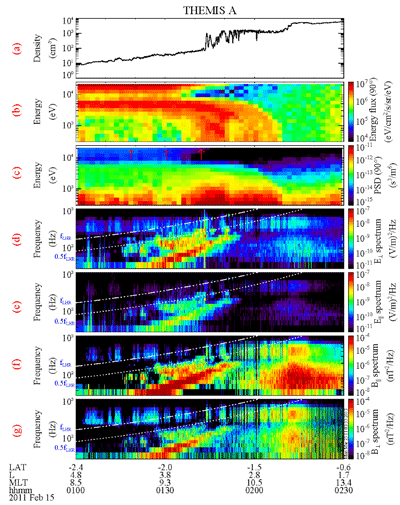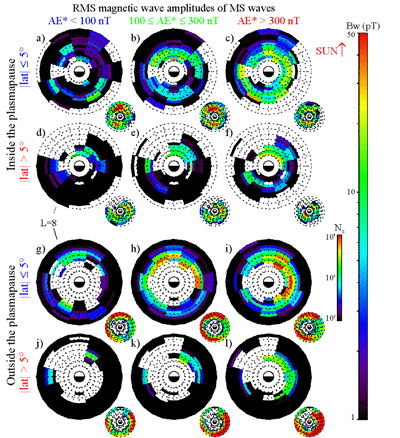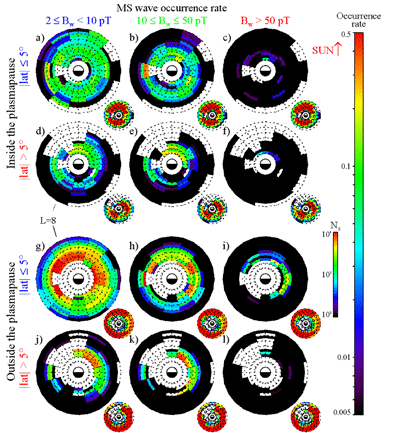
2013 THEMIS SCIENCE NUGGETS
Global distribution of equatorial magnetosonic waves observed by THEMIS
by Qianli Ma, Atmospheric & Oceanic Sciences, UCLA
Introduction
Equatorial magnetosonic (MS) waves are natural electromagnetic emissions excited at frequencies between the proton gyrofrequency (fcp) and the lower hybrid resonance frequency (fLHR) in a spatially localized region near the Earth’s magnetic equator, with propagation direction nearly perpendicular to the background magnetic field. When energetic ions are injected from the nightside plasmasheet and experience energy dependent drift around the Earth, positive gradients in the perpendicular velocity distribution of protons develop mainly on the dayside; these gradients can provide the free energy to excite MS waves. The excited MS waves are able to interact with and cause local acceleration of energetic electrons via Landau resonance. Consequently, a comprehensive global model for the spatial distribution and spectral properties of MS waves needs to be developed for use in future global modeling. The present study provides essential information regarding the regions and conditions in which the MS waves become most effective in scattering the particles in the Earth’s radiation belts.
Results
A typical MS wave event observed by THEMIS is shown in Figure 1. MS waves are highly oblique plasma emissions and are characterized with much stronger E⊥ and B∥ intensity compared with E∥ and B⊥. MS waves are observed both inside and outside the plasmapause within 2.3° of the magnetic equator in the prenoon sector. Outside the plasmapause, two distinct frequency bands of MS waves are observed with the frequencies following the variation of fLHR and are always below 0.5fLHR (Figures 1d and 1f). In Figure 1c, positive gradients of the ion PSD for ~ 90° pitch angles as a function of energy are observed simultaneously for ~10 keV ions, indicating that the waves outside the plasmapause are probably locally excited. Inside the plasmapause, MS waves are observed between 40 Hz and 200 Hz with unstructured frequency spectra, and no local positive ion PSD gradients are observed, suggesting that these waves inside the plasmapause are not locally generated and have probably propagated to this location from a distant source.
| Figure 1. A typical example of MS waves observed by THEMIS A on 15 February 2011. (a) The total plasma density (inferred from the spacecraft potential); (b) energy spectrum of ion energy flux for a pitch angle of ~ 90° ; (c) energy spectrum of ion PSD for a pitch angle of ~ 90° ; (d) power spectral density of E⊥; (e) E∥; (f) B∥; and (g) B⊥. fLHR and 0.5fLHR are denoted as the dash-dotted line and dotted line, respectively. The red arrows in Figure 1c indicate several examples of the positive gradients in ion PSD distribution. |
Figure 2 shows the global distribution of the root mean square magnetic field amplitude (Bw) of MS waves categorized by AE* (the maximum geomagnetic AE index in the previous 3 h) and magnetic latitude (LAT). The distribution is shown both inside and outside the plasmapause. Strongest MS waves are found on the dawnside between 3 and 6 RE at |LAT| < 5° , in the region outside the plasmapause, for geomagnetically disturbed conditions (AE* > 300 nT). Relatively high-latitude but weak MS waves are observed at low L shells and under disturbed conditions both inside and outside the plasmapause. MS wave amplitudes inside the plasmapause are much weaker than those outside the plasmaspause. The MS wave distribution outside the plasmapause shows stronger wave amplitudes for larger AE*, and also shifts toward earlier magnetic local time (MLT) as AE* increases.
| Figure 2. The global distribution of RMS wave amplitude Bw for 2 < L < 8. The wave intensity is categorized by LAT and AE* and shown for locations inside (top panels) and outside (bottom panels) the plasmapause. The sample number (Ns) is shown as smaller plots at the right bottom corner for each panel. White area represents the region where Ns is less than 100. |
Figure 3 shows the global distribution of MS wave occurrence rate for various levels of wave amplitude. The occurrence rate of strong MS waves (Bw > 50 pT) peaks near 20% outside the plasmapause at L ~ 4, near the equator, and in the dawn sector. The waves inside the plasmapause have more uniform distribution in MLT than outside. The majority of MS waves inside the plasmapause tend to have constant frequency spectra, while the waves outside tend to follow the fLHR, as shown in Figure 1. This supports the concept that MS waves inside the plasmapause are likely to have propagated azimuthally and radially from other regions, while the MS waves outside the plasmapause are more likely to be excited locally.
| Figure 3. The same format as Figure 2 but for the occurrence rate of MS waves with various wave amplitudes. |
Conclusion
The main conclusions are summarized as follows: (1) strongest MS waves (~50 pT and occurrence rate of ~20%) occur near the magnetic equator, in the dawn sector outside the plasmapause, under disturbed conditions; (2) MS waves outside the plasmasphere are stronger than those inside, and the MS waves are distributed more uniformly in MLT inside the plasmapause than outside; (3) the MS wave amplitudes are stronger near the equator than those at higher latitudes; (4) the increase in AE* has more influence for the waves outside the plasmapause than inside, and the location of strongest MS waves shifts to earlier MLT particularly in the region outside the plamasphere; (5) MS waves observed outside the plasmapause are likely to be generated locally, whereas MS waves inside the plasmapause are likely to have propagated from other regions.
Reference
Ma Q., W. Li, R. M. Thorne, and V. Angelopoulos (2013), Global distribution of equatorial magnetosonic waves observed by THEMIS, Geophys. Res. Lett., 40, 1895-1901, doi:10.1002/grl.50434.Biographical Note
Qianli Ma is a fourth year PhD student in space physics at University of California, Los Angeles. He is studying the global distribution, excitation, propagation, and potential effects in particle scattering of magnetosonic waves in the Earth’s inner magnetosphere.
 Please send comments/suggestions to
Emmanuel Masongsong / emasongsong @ igpp.ucla.edu
Please send comments/suggestions to
Emmanuel Masongsong / emasongsong @ igpp.ucla.edu



